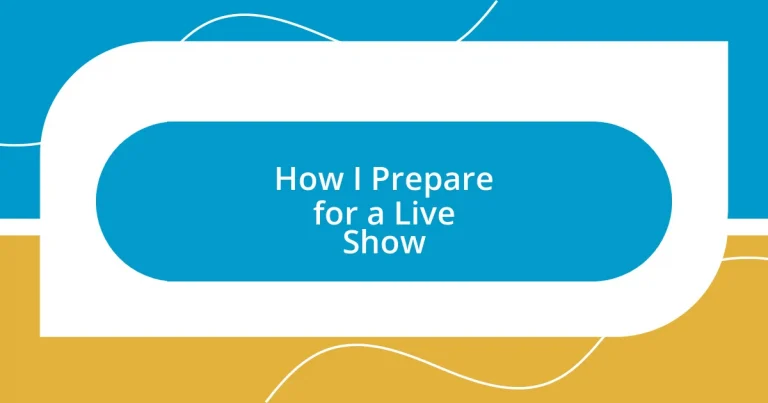Key takeaways:
- Setting clear, flexible goals and focusing on measurable outcomes enhances performance effectiveness and audience engagement.
- Thorough venue research, including acoustics and audience dynamics, significantly impacts performance preparation and delivery.
- Creating a detailed schedule with contingency plans and conducting regular rehearsals boosts confidence and allows for better adaptability during live shows.
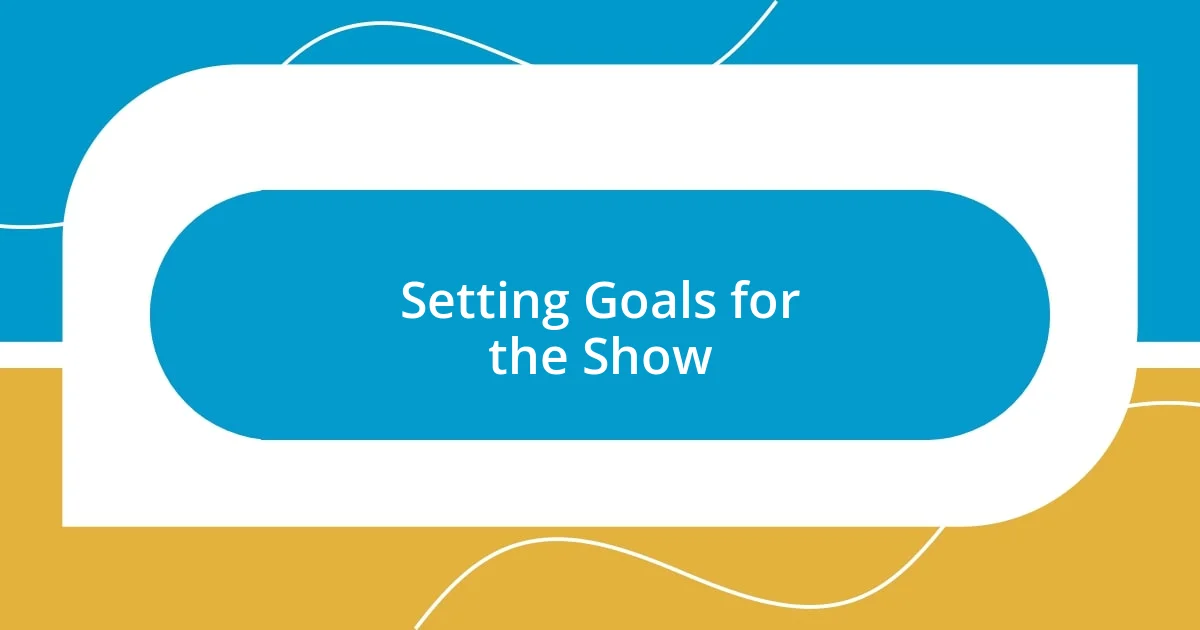
Setting Goals for the Show
When I set goals for a live show, I like to start with a clear vision in mind. I’ve learned that asking myself what I want the audience to feel or take away helps shape my objectives. For instance, during one of my earlier performances, I aimed not just to entertain but to inspire, which shifted my approach to the entire set.
Another aspect that resonates with me is the idea of measurable outcomes. I often use specific metrics, like audience engagement levels or social media interactions, to gauge success. This method was particularly impactful during a show I did at a local venue where my goal was to double interactions compared to my last performance—it was exhilarating to reach that target!
Lastly, I believe it’s essential to remain flexible about the goals I set. Live shows can be unpredictable, and adaptability is key. Have you ever experienced a moment where your original goal shifted on stage? I have, and those moments often turn into the most memorable parts of the show. It reminds me that while goals are crucial, being responsive to the audience is just as important.
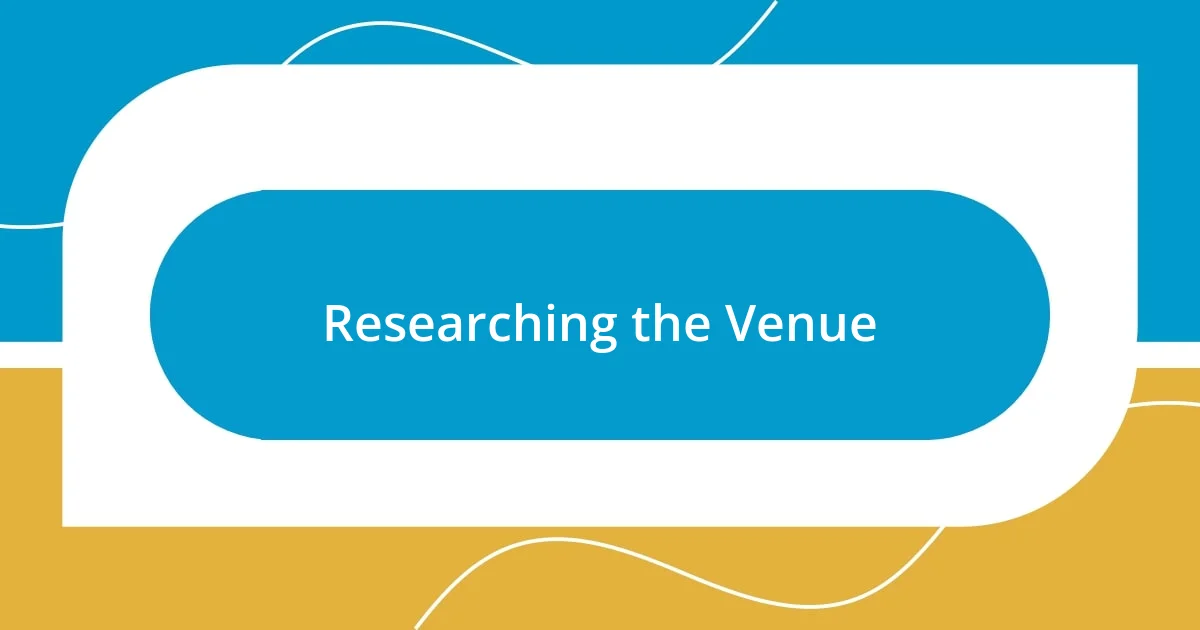
Researching the Venue
Researching the venue is a crucial step in my preparation process. I’ve often found that knowing the space I’ll be performing in can significantly impact my performance. For example, before a recent show at a cozy, local theater, I took the time to explore the layout, including the stage size and audience seating arrangement. This familiarity allowed me to visualize my set and plan the flow of my performance, which made me feel more at ease on the day of the show.
When I look into a venue, here’s what I typically focus on:
– Acoustics: How does the space affect sound? I remember a performance where the reverberation was so pronounced that I had to adjust my vocals.
– Lighting: What’s the natural light or fixture situation? Once, the lighting in a venue completely transformed the mood of my set, enhancing the emotional connection with the audience.
– Backstage Facilities: Are there adequate spaces for warm-ups? This can be a game-changer, especially for feeling grounded before hitting the stage.
– Technical Equipment: What sound and video gear are available? I recall a time when having great tech support allowed me to showcase my music in the best light possible.
– Audience Engagement Potential: How closely will I be able to connect with the audience? In one performance, a more intimate venue made the interaction feel electric, and that energy resonated throughout my entire set.
Each of these elements offers insights that help me craft a show that resonates not just with me, but with the audience as well.
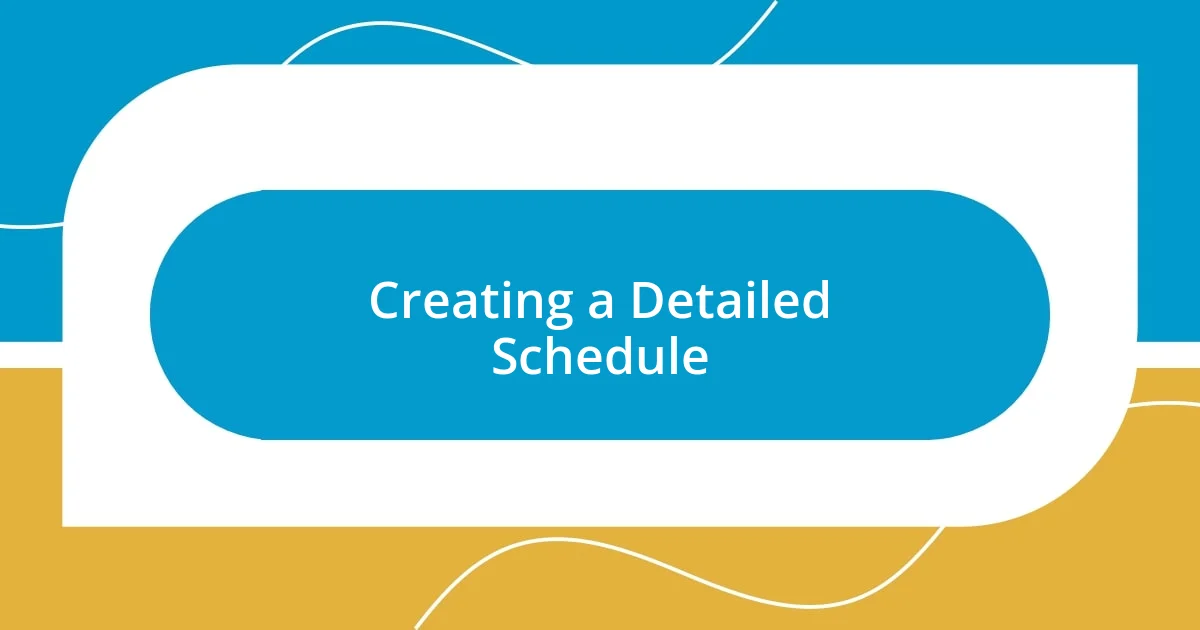
Creating a Detailed Schedule
Creating a detailed schedule is like crafting the blueprint for a successful live show. Personally, I block out every hour leading up to the performance, including everything from rehearsals to relaxation time. During one of my earlier gigs, I realized the importance of precision; I scheduled a 30-minute warm-up session that left me feeling excited rather than rushed. When we consider each minute leading up to the show, it really changes our perspective, don’t you think?
I also make sure to include contingency plans. For instance, if a rehearsal runs late, I have a buffer period built into my schedule. This saved me during a particularly nerve-wracking performance where a technical issue popped up last minute. Having that little extra time allowed me to breathe and tackle the problem without feeling overwhelmed. Isn’t it reassuring to know that a well-thought-out schedule can help ease some of the unpredictability of live shows?
Moreover, I always reflect on my show timing. I categorize my schedule into segments: preparation, performance, and post-show wrap-up. During one show, I stuck to my post-performance checklist and realized that it helped me decompress effectively. It’s incredible how a structured approach can enhance not just the performance, but also my overall experience as an artist.
| Time Blocks | Activities |
|---|---|
| Pre-Show | Rehearsals, vocal warm-ups, technical checks, and relaxation. |
| Showtime | Performance time, audience engagement, and dynamic adjustments. |
| Post-Show | Debriefing with the team, gathering feedback, and unwinding. |
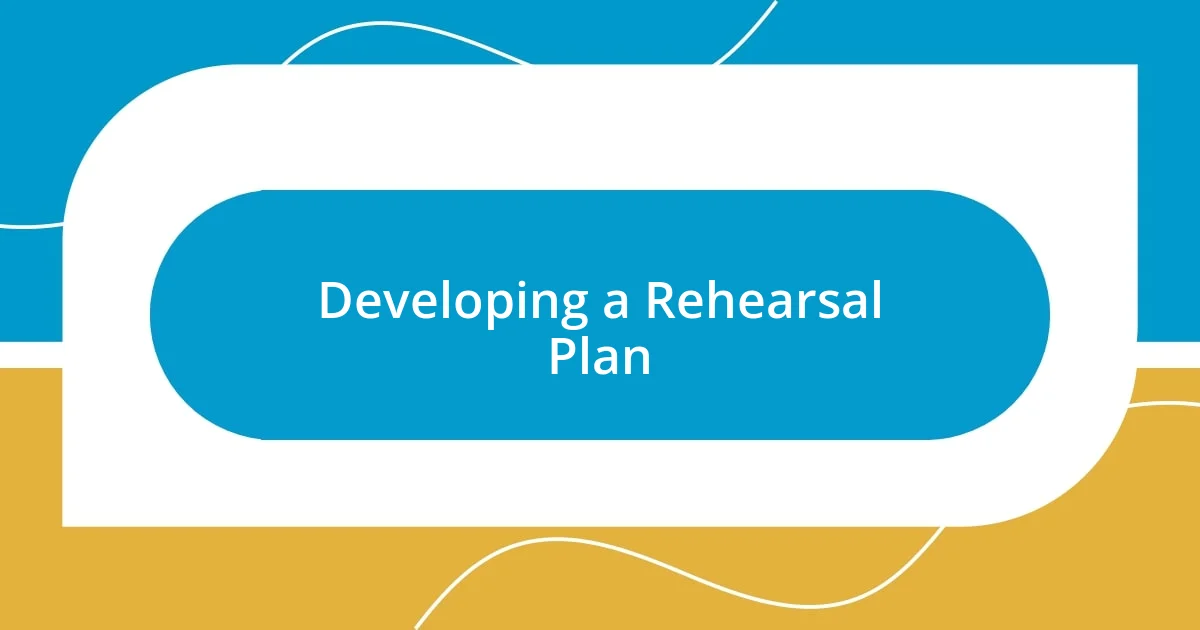
Developing a Rehearsal Plan
Developing a rehearsal plan is vital for my performance preparation. I often start by identifying which elements of the show need the most attention. For example, in one of my recent performances, I realized my transitions between songs weren’t smooth during practice, so I dedicated extra rehearsal time specifically to perfecting those. It’s interesting how pinpointing one detail can have such a significant impact on the overall flow, isn’t it?
I typically break my rehearsal time into various segments focused on different aspects—vocals, instrumental practice, and stage presence. One time, while rehearsing for a big event, I concentrated solely on my stage movements. Afterward, I noticed a remarkable shift in my comfort level during the show. It’s amazing how rehearsing specific actions can make them feel second nature when the spotlight is on. Do you find that focusing on smaller details helps you feel more confident in high-pressure situations?
Additionally, I make it a point to rehearse in the actual space whenever possible. This practice has helped me visualize how everything will come together. During a particularly memorable show, doing a run-through at the venue allowed me to experiment with the lighting and audience dynamics. This rehearsal not only built my confidence but also gave me a chance to adapt my performance to the space, creating an unforgettable connection with the audience. Isn’t it fascinating how a few thoughtful preparations can resonate so deeply?
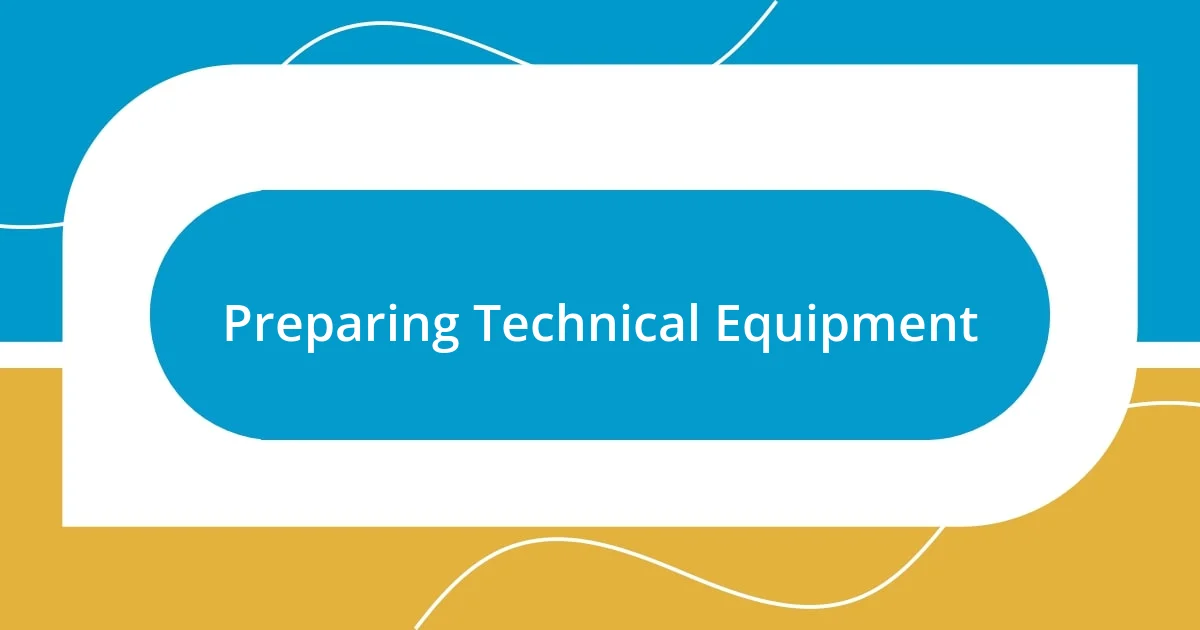
Preparing Technical Equipment
Preparing my technical equipment can often feel like a puzzle that requires meticulous attention to detail. I remember one time when I discovered the importance of testing everything a day before the performance. I had a back-up laptop ready to go, but when it malfunctioned unexpectedly, my primary machine saved the day. How many times do we take equipment for granted until we really need it?
Beyond just bringing the right gear, I also ensure that all my cables and connectors are organized and functioning properly. There was a situation during a live show where I encountered a faulty microphone cord that threatened to derail my performance. Fortunately, I had a secondary mic conveniently set up to step in with no interruptions. In those moments, I’ve realized that redundancy isn’t just a precaution; it’s a lifeline under pressure.
I also take time to familiarize myself with the venue’s technical setup. A few weeks ago, I made it a point to arrive early to run through the soundcheck and lighting adjustments. It was enlightening to see how the venue’s acoustics affected my sound. I learned that understanding the environment truly makes a difference in how I connect with the audience. Have you ever adjusted your performance based on your surroundings? It can lead to such rewarding experiences.
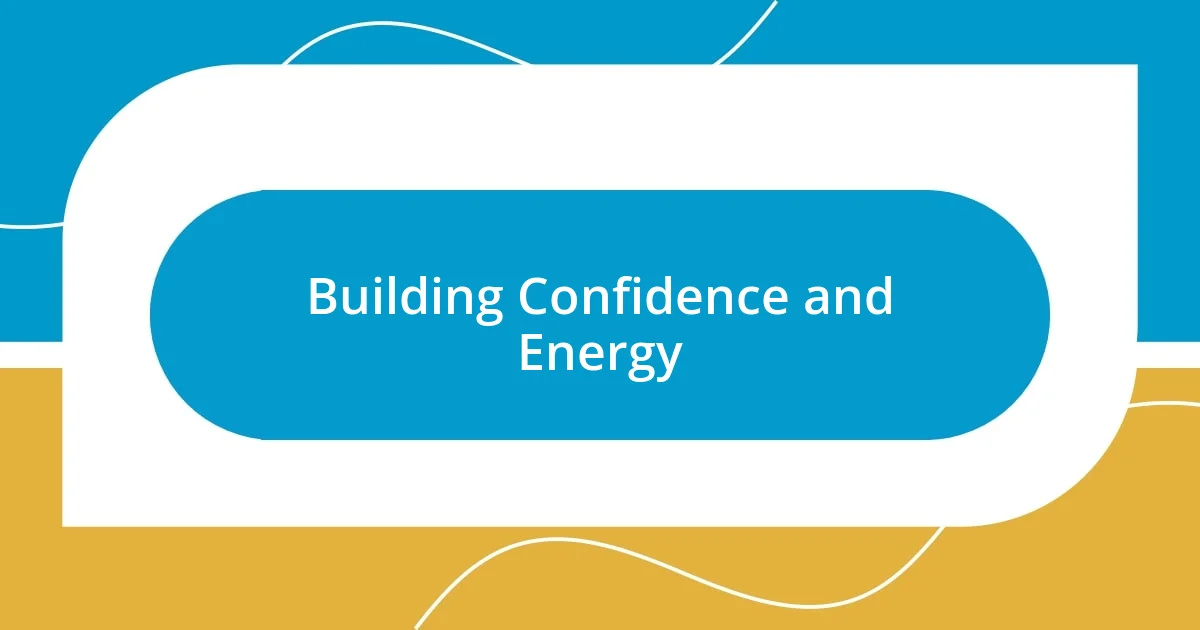
Building Confidence and Energy
Building confidence for a live show often comes down to my mindset. Before stepping on stage, I indulge in a little pre-show ritual that boosts my energy. I remember a particularly nerve-wracking evening when I jumped around backstage, blasting my favorite upbeat playlist. The moment the music filled the space, my mood shifted. Isn’t it interesting how a song can completely transform your energy?
Visualizing my performance is another technique I find impactful. I often close my eyes and picture myself delivering an electrifying show; the audience is engaged, and the atmosphere is charged. There was one time I did this before a big gig, and I felt butterflies in my stomach turn into a confident roar. It’s almost like I practice not just my performance but also the emotions I want to convey. Do you ever think about how powerful visualization can be before a big moment?
Additionally, I find that connecting with fellow performers can elevate my confidence. Before hitting the stage, I like to chat with my bandmates or crew about our excitement for the show. It’s a simple act, but sharing those positive vibes really builds a supportive energy. I recall a fun conversation we had just before a festival performance where we joked about how nervous we all were. Laughing together helped ease the tension and sparked a sense of camaraderie. Have you ever experienced how sharing enthusiasm can shift the atmosphere? It’s those moments that remind me we’re in this together, and that support fuels my confidence to shine.
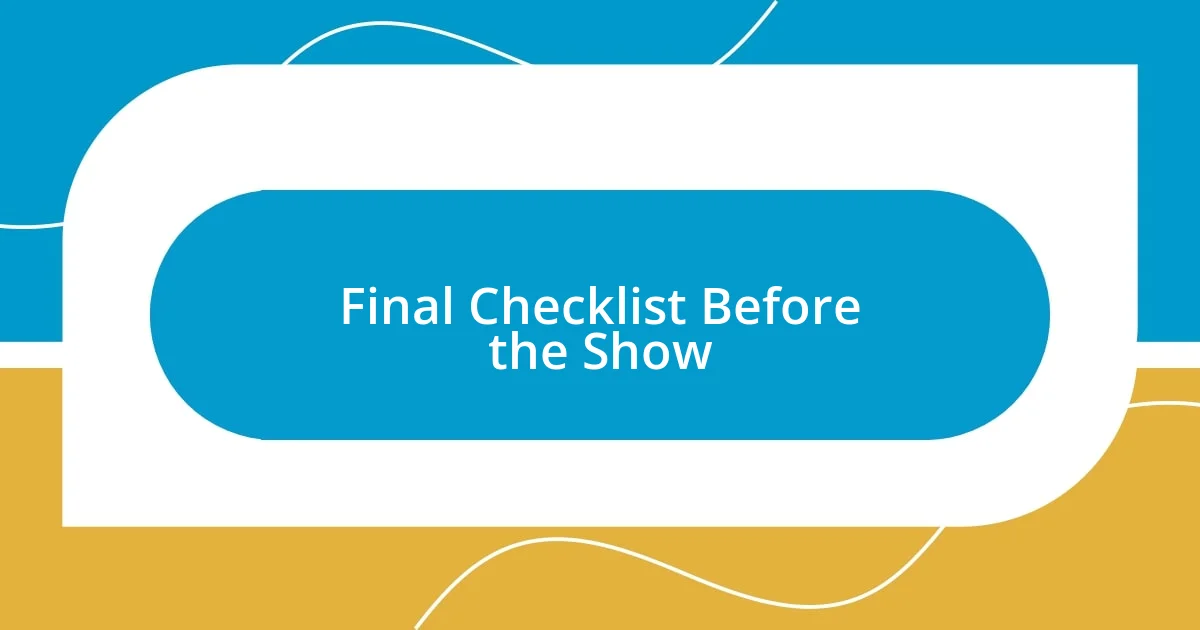
Final Checklist Before the Show
Before I head out for a show, I always jot down a final checklist of essentials. It starts with reviewing my setlist to ensure I have everything in order, both emotionally and technically. I remember one time when I forgot a critical song transition; the night became a mad scramble to get back on track. Does checking off items feel like a personal victory for you too?
I also make it a habit to pack a mini emergency kit. I include items like extra guitar strings, snacks to keep my energy up, and even a small first-aid kit. One unforgettable moment was during a show in the rain, when my strings snapped right before a crucial song. Thankfully, I had my spare pack on hand. It’s amazing how these little details can make a huge difference in navigating unexpected challenges.
Lastly, I take a moment to mentally center myself before stepping onto the stage. This isn’t just about calming nerves; it’s about aligning my thoughts with the energy I want to share. I recall a time when I felt a wave of anxiety wash over me right before I went on, but I took a breath, closed my eyes, and visualized the crowd roaring with excitement. Have you ever experienced a moment where breathing deeply transformed your state of mind? It truly works wonders in setting the right tone for the performance ahead.












